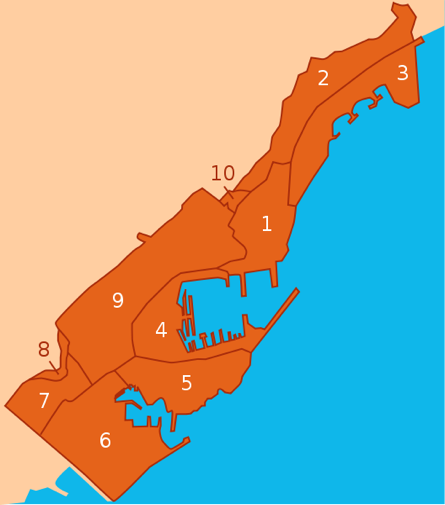Monaco Districts
In 1917 the municipalities in Monaco were merged into just one municipality (commune) and there is no real distinction between the State and City of Monaco. The responsibilities of the government and of the municipality are somewhat different though.
According to the constitution of 1911, the Principality of Monaco was divided into three municipalities and today divided into 10 wards.
Monaco
Monaco, the old city on a rocky promontory extending into the Mediterranean, known as the Rock of Monaco, or simply Le Rocher (the Rock), where the Prince’s Palace, the ramparts, the gardens, The Cathedral and the Oceanographic Museum are located.
The Rock is also host to some 50 small boutiques offering souvenirs and local arts and crafts as well as charming restaurants with a large selection of regional cuisines.
The former municipality of Monaco is now the ward of Monaco-Ville.
Monte Carlo
Monte Carlo, the principal residential and resort area which include the famous Monte Carlo Casino and Hotel de Paris among other landmarks. Built starting in 1870, during the reign of Charles III, Monte Carlo occupies the old Spelugues plateau. This area contains the largest concentration of stores and features one of the most beautiful shopping centers in Europe.
The former Monte Carlo municipality consists of the following wards:
- Monte Carlo / Spélugues (Boulevard Des Moulins – Avenue de la Madone)
- La Rousse / Saint Roman (Annonciade – Château Périgord)
- Larvotto / Bas Moulins (Larvotto – Boulevard Princesse Grace)
- Saint Michel (Boulevard Princess Charlotte – Park Palace)
La Condamine
La Condamine is the northwest section which include the port area, Port Hercule and is featuring the most commercial activities attracting merchant ships whose cargoes could be negotiated. La Condamine is the oldest commercial quarter of the Principality of Monaco and also hosts the Condamine market.
The former La Condamine municipality consists of the following districts;
- La Condamine
- La Colle (Plati – Pasteur – Boulevard Charles III)
- Les Révoires (Hector Otto – Honoré Labande) including Jardin Exotique de Monaco
- Moneghetti / Boulevard de Belgique (Bvd Rainier III – Bvd de Belgique)
Fontvieille
Fontvieille named based on an ancient spring found there and is the economical and industrial area. It is a newly constructed area reclaimed from the sea in the 1970s and was added as fourth ward.
In 1905 a brewery, a flour mill and a chocolate plant among other industries were located in Fontvieille. Today the modern 22 hectare area is populated by numerous businesses, residents as well as some 80 stores.
The traditional quarters of Monaco are; Monaco-Ville, La Condamine, Monte Carlo and Fontvieille. These four quarters plus Moneghetti are now defined by the Monaco Department of Tourism as the five modern geographic areas in the Principality of Monaco.
Monaco Wards
Below a list of the ten wards as mapped above (the numbering is for illustration purposes only):
- 01 – Monte Carlo / Spélugues
- 02 – La Rousse / Saint Roman
- 03 – Larvotto/Bas Moulins
- 04 – La Condamine
- 05 – Monaco-Ville
- 06 – Fontvieille
- 07 – La Colle
- 08 – Les Révoires
- 09 – Moneghetti/ Boulevard de Belgique
- 10 – Saint Michel
Map of the wards by Notscott
